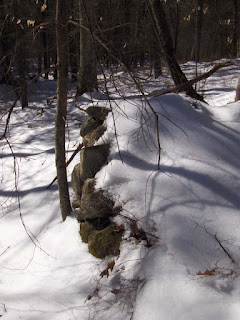by theseventhgenerationHere are some views of stone piles with vertical faces at the site I frequent the most in NY.
This is the largest stone pile at the site. The view is looking toward the water source, with the vertical face on the right side of the pile. That's a 4 ft walking stick on top of the pile.

Looking away from the water source, there is a view with the large stone pile to the right and a smaller stone pile to the left. Can you see anything up there in the back, between the piles?

I went back out after a snowstorm to confirm my suspicion, that I was seeing it right. Here is a view closer to the smaller stone pile. The vertical face of the smaller stone pile seems to run in the direction of that nice stone pile in the back.

Another view, from a much smaller, less organized stone pile at this end of the site reveals something very similar. The smaller stone pile in the foreground has a vertical face. Because it's so low in the snow, I added markings to the photo to highlight the vertical face and the stone pile in the background.

Looking back at this photo (above), the stone pile in the background, being slightly to the right of the vertical face, is not what I would expect to find. But, it is what it is. There are other stone piles at this site, but I focused on these 4 because the view from one pile to the next, through the snow and pines, was clear. So, although accuracy may be lacking, the photos don't deny that there may be a relationship between some of the vertical faces and the large, beehive shaped stone pile in the background.
Here is a photo of that beehive shaped stone pile:

One last view. The most recent stone pile I found at this site and the wall bulge. A tree blocks the view from the short vertical face to the wall bulge, so I stood in the middle, by the tree and took two photos in opposite directions. The first photo is cropped to try to focus in on the short vertical face.




















































